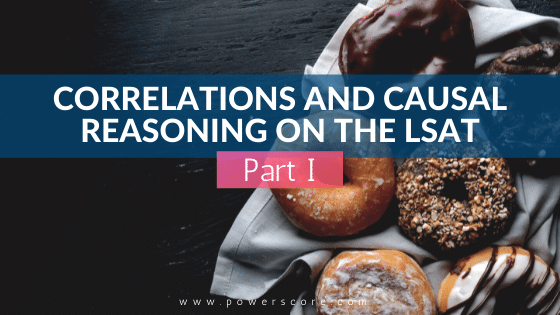The makers of the LSAT frequently create arguments that conflate correlation with causation, and thus you must understand the distinction between the two. This is the first in a 3 part series that discusses Correlations and Causal Reasoning on the LSAT. Let’s get into it!
Correlation & Causal Relationships
In statistics, “correlation” refers to a statistical relationship between two interdependent variables (e.g. height and weight, studying and grades, etc.). A correlation alone does not prove a causal relationship. But it can suggest that a causal relationship does, in fact, exist. For instance, you cannot interpret a correlation between height and weight to mean that either one causes the other. On the other hand, a correlation between studying and grades implies that studying causes higher grades. Still, the correlation alone is not sufficient to prove that such a causal relationship exists.
An empirically observable correlation between two interdependent variables is a necessary, but not sufficient, condition for causality.
Explanation
On the LSAT, correlations usually function as evidence presented in support of a causal conclusion:
Premise: A and B are correlated
Conclusion: A causes B
Usually, the problem with such arguments is the presumption that correlation proves causation. It does not, as there could be some third factor that could explain (i.e. provide a causal explanation for) the observed correlation, or other means of interpreting the relationship.
Example
An example of a typical causal argument involving a correlation:
Scientists have long suspected that isoflavones, a class of biologically active organic compounds, tend to improve one’s cognitive performance. Now these views have acquired strong support from a recent study showing that college students who took soy isoflavone supplements for 3 months did significantly better on various reasoning tasks than students who never took such supplements.
The structure of the argument is as follows:
Premise: Soy isoflavone supplementation is correlated with improved cognitive performance.
Conclusion: Soy isoflavone supplementation causes an improvement in cognitive performance.
Consider Why the Correlation May Not Be Sufficient
When analyzing such arguments, it’s important to consider why the correlation may not be sufficient to establish the causal conclusion. The problem is usually with the way in which the study was controlled. For instance, if the students examined were not randomly assigned to each group, this would imply a selection bias in the experimental group and compromise the validity of the conclusion. Indeed, if those who are particularly ambitious tend to take performance-enhancing supplements. They also tend to do better on various reasoning tasks than their less-ambitious counterparts, so a third factor could explain the correlation between isoflavone supplementation and performance, causing both “cause” and the “effect.”
Eliminate Bias
To eliminate the possibility of bias, it may also be important to conduct a double-blind study in which neither the students nor the researchers know who belongs to the control group and who belongs to the experimental group until after all data have been recorded. Without a double-blind study, it is possible that the correlation is a function of a placebo effect or of the experimenters’ own subjective bias towards the result they expect.
The following question types typically follow arguments that follow this pattern of reasoning:
- Weaken
- Strengthen
- Assumption
- Flaw in the Reasoning
Part II of this blog article will examine how each of these question types tests your ability to understand the difference between correlations and causations and provide examples of several correct and incorrect answer choices for each question type. Stay tuned!


Leave a Reply